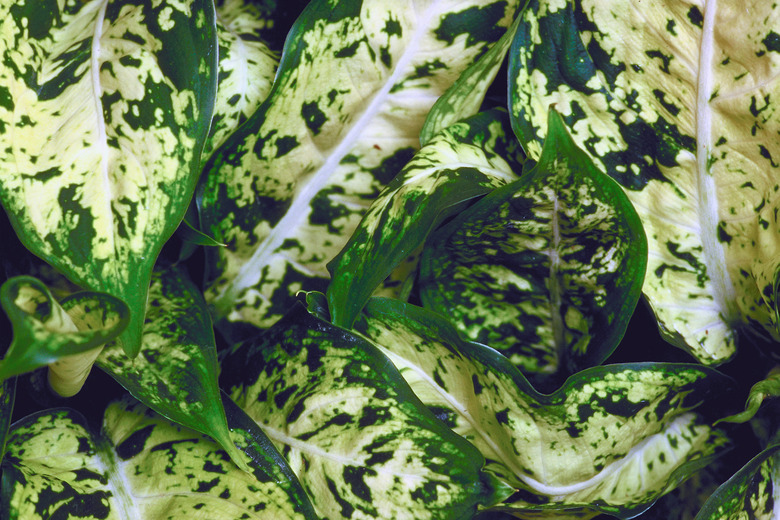How To Split A Dieffenbachia Plant
The genus Dieffenbachia includes tropical foliage plants that are hardy in U.S. Department of Agriculture plant hardiness zones 10 through 12, but are grown as houseplants in colder climates. The plant gets the name dumbcane because its stems contain skin-irritating needle-like raphides that cause a burning sensation in the mouth and throat when ingested, literally making one speechless. Although mothers might wish for quiet when the kids are running around screaming, you should definitely keep this toxic plant out of the reach of children, particularly when dividing to make new plants and exposing the inner flesh.
Dividing Plant
Step 1
Step 1
Wear heavy gloves, long sleeves and safety glasses before splitting the dumbcane plant, so the sap doesn't touch your skin or eyes. Wear a breathing mask to keep it out of your mouth or hold your mouth closed while working with dieffenbachia.
Step 2
Step 2
Cut a circle around the dieffenbachia plant that measures about 4 inches outside the outer perimeter of the stems. Use a digging spade to cut the circle, insert the blade in the cut and pull back on the handle to pry it out of the ground. If you grow dieffenbachia in a container, just slide the root ball out of its container.
- The genus Dieffenbachia includes tropical foliage plants that are hardy in U.S. Department of Agriculture plant hardiness zones 10 through 12, but are grown as houseplants in colder climates.
- Although mothers might wish for quiet when the kids are running around screaming, you should definitely keep this toxic plant out of the reach of children, particularly when dividing to make new plants and exposing the inner flesh.
Step 3
Step 3
Brush excess soil away from the outside of the root ball until you expose some of the roots and canes. Use your hands or a small cleaning brush.
Step 4
Step 4
Look for natural separations among the various canes of the plant. Although all canes are part of the same plant, some might appear to be grouped together.
Step 5
Step 5
Pull these groups apart to split the plant into two to four separate plants, depending on the size of the original dumbcane plant. If you can't pull them apart by hand, use a sterile knife or pruning saw to cut through the soil. Disinfect the knife or saw in a solution of one part bleach to nine parts water before and after use.
- Brush excess soil away from the outside of the root ball until you expose some of the roots and canes.
- Pull these groups apart to split the plant into two to four separate plants, depending on the size of the original dumbcane plant.
Step 6
Step 6
Return one of the sections to the original container or planting location. Plant the remaining sections in new containers or planting sites that receive partial to full shade, no more than two hours of sunlight daily. An outdoor planting site must have well-drained soil, while containers need a potting soil with good drainage that is rich in organic matter.
Tip
The potentially harmful effects of dumbcane sap doesn't mean you can't enjoy this plant in your home. Display the plant in a high window or on a counter far from children's reach. Wait until the kids are down for a nap or gone to bed for the night before attempting to split the plant and you won't have to worry about them coming in contact with the sap.
Things Needed
- Heavy gloves
- Long sleeves
- Safety glasses
- Breathing mask
- Digging spade
- Cleaning brush
- Bleach
- Knife or pruning saw
References
- Purdue University Consumer Horticulture: New Plants from Cuttings
- Clemson Cooperative Extension: Dieffenbachia
- North Dakota State University Extension: Questions on: Dieffenbachia
- Missouri Botanical Garden: Dieffenbachia Seguine
- North Carolina State Univeristy Extension: Plant Propagation by Leaf, Cane, and Root Cuttings: Instructions for the Home Gardener
